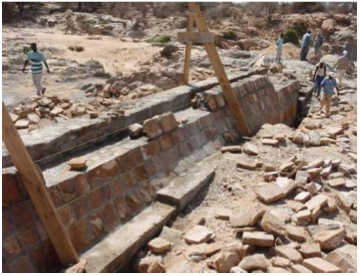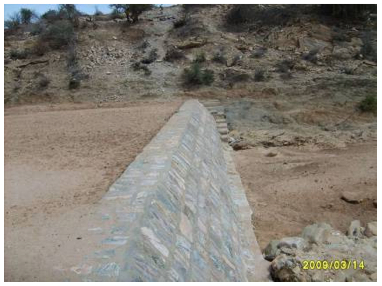Difference between revisions of "沙坝"
| Line 180: | Line 180: | ||
|- | |- | ||
|{{#ev:youtube|r-FqlHQxvGk|200|auto|<center>基图伊沙坝</center>}} | |{{#ev:youtube|r-FqlHQxvGk|200|auto|<center>基图伊沙坝</center>}} | ||
| − | |{{#ev:youtube|aOH7ar274S4|200|auto|<center>RAIN沙坝探讨会<br> | + | |{{#ev:youtube|aOH7ar274S4|200|auto|<center>RAIN沙坝探讨会<br>与2009年埃塞俄比亚实地考察</center>}} |
|{{#ev:youtube|YjzcfPax4As|200|auto|<center>卓越基金会(Excellent)- 肯尼亚沙坝</center>}} | |{{#ev:youtube|YjzcfPax4As|200|auto|<center>卓越基金会(Excellent)- 肯尼亚沙坝</center>}} | ||
|{{#ev:youtube|2Vz2kaL2bs4|200|auto|<center>斯科特·威尔逊千禧年(Scott Wilson Millennium) <br>项目 - 肯尼亚,2010</center>}} | |{{#ev:youtube|2Vz2kaL2bs4|200|auto|<center>斯科特·威尔逊千禧年(Scott Wilson Millennium) <br>项目 - 肯尼亚,2010</center>}} | ||
|} | |} | ||
| − | ==== | + | ====链接==== |
* [http://www.excellentdevelopment.com/home Excellent: Pioneers of San Dams]. | * [http://www.excellentdevelopment.com/home Excellent: Pioneers of San Dams]. | ||
* [http://acaciawateruk.standaardsite.nl/pg-29143-7-89562/pagina/welcome.html ACACIA Water]. The strength of Acacia Water is the specialization in the field of groundwater, while at the same time being able to place issues in a broader perspective and to link up with other fields of action. As a result we often work in a multidisciplinary environment with a broad variety of expertise. | * [http://acaciawateruk.standaardsite.nl/pg-29143-7-89562/pagina/welcome.html ACACIA Water]. The strength of Acacia Water is the specialization in the field of groundwater, while at the same time being able to place issues in a broader perspective and to link up with other fields of action. As a result we often work in a multidisciplinary environment with a broad variety of expertise. | ||
Revision as of 06:43, 8 September 2015
沙坝是一种建造简便、成本低、维护工作量少且易复制再造的雨水收集技术。沙坝为家庭及农场提供清洁的当地用水,适用于全球的半干旱地区。
在降雨量极不稳定的地区,通常砂质河床上会有季节性水流临时流经。这些地区只在雨后才有短时大量的径流,而大量的沙会在这一时段被带到下游。在流动过程中,一些沙会被阻挡在上游突出的岩石处,于是,天然水中的这些沙子便形成砂石含水层。沙坝技术由此应运而生,重现这种集水机制,扩大现有的砂石含水层规模。
天然集水的区域通常汇集了清洁的饮用水,但数量有限,很快便会耗尽。而沙坝对砂质河床进行了人工改进,能补给、储存更多水,以供备用。用混凝土、黏土或石材在河道的一些特定处建造水坝,为的是能在洪水期间留住沙子;这样便创造了额外的地下水储备,在旱季得以利用。
如果选址准确适宜,沙坝中可用的总水量至少有6000立方米。
沙坝项目不仅提高了水的可供性,也有利于社区的社交和经济。当地人会获得培训,参与建设和维护沙坝,并管理财务和自然资源。
适宜条件
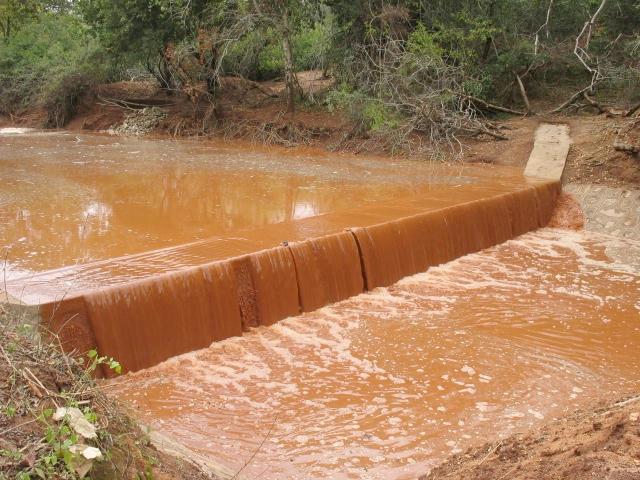
沙坝可因家庭、社区甚至市政用途建造使用。有些沙坝通过渗渠、排水井和泵站与市政水管系统连接。
然而,选定建坝的最佳位置需要专业知识的投入,确保项目能适应当地社区的实地条件和社会环境。在每一个集水区设立一位工匠领队来进行选址或可提高成功率。从实际出发,选址必须适宜建造沙坝,能提供安全的饮用水,也能利用沙子的沉积增加水的供给。首先,必须判定河流是否适宜;第二,必须选择河床的最佳区段;随后,确定最佳选址。
通常而言,沙坝需要建在丘陵地带中的砂质河床上。河床最好有不透水的基岩,上面铺有粗砂。河流需是季节性的,但必须有基本流量。要判断河流是否符合上述条件,可以观察生长在河边的植被种类。河流不能太宽(最宽25米),两边需要有较高的河堤。
请确保把沙坝建在河水会流经坝体的区域,两边河堤要等高,高度要足够(坝高+洪水水位+10%),且不要把沙坝建在河流弯道附近。
以下选址能防止漏水:
- 要有非渗透性的基岩或黏土,而非有裂缝的石头。一个实用的判断指征是,在旱季是否有先前就存在的地下水流,并且,在河床上是否有较大的岩石和卵石。选址时需要特别留意,因为在这些情况下,沙坝下方可能会出现渗漏。
- 选址在基层上,而非在沙中的黏土透镜体上。
- 要在确定的河堤间,若河堤任一边有旧河床,则需确保旧河床不会使沙坝边缘有地下水存在。
要选择斜度适宜留住沙子而不是淤泥的地方建坝。水流速度至少要达到每秒0.45米才会留下较少淤泥,因此,这样的区域就需要斜坡角度适宜——若太平便会有太多小颗粒和淤泥。坡度越平,河床便越宽,而建沙坝必须要25米以下的河宽。据说最佳的斜度是在0.125%至4%之间;虽然也可以高于4%的值,但会造成沙储备量减少。若想要确定粒径分布,沙子分析是一种较简易的实地检测方法,或者可以通过孔隙率和单位出水量测试来推断沙子可能的类型。中粒砂可以最好地平衡孔隙率和单位出水量,因此是最需要的类型。
如果河流较窄,并有阻挡地下水的天然屏障,这样的选址因沙量已达最多,能降低建坝成本。要找到这样的屏障,可以通过观察雨后积水在勺状孔中的位置,或通过探针、螺旋钻和浅探井,或空气压缩机钻孔等方法。
避免在上游河堤有盐岩(呈白色和粉红色)的区域选址,否则会使水中含盐。
在同一条河上建坝要有秩序,以避免所有人过度使用同一水源,造成可能的生态破坏。而坝间距太近则会使各自影响的区域重叠,会造成水位普遍升高,而可供使用的总水量降低。对每一区域而言,水量更为重要,因此最好设立最小坝间距(以往,肯尼亚的最小坝间距为700米,坝每边350米是影响区域,但需视不同地点而定)。
建坝适宜条件也与其它因素相关,如:气候,有无卵石,同时也必须具体分析河床倾斜度来判定选址是否合适。并且,虽然实地条件可通过人为来改善,但水质必须达到可以饮用的级别(不能含盐太多,不能受污染,等)。
| 优势 | 不足 |
|---|---|
|
- 全年都有质量优良的水源和地下水补给 |
- Site-specific technology – not suitable everywhere.这一技术适用于特定场地——并非适用于所有地点 |
顺应环境变化
干旱
干旱效应:会干涸;出水量低。
潜在的因果关系:减少的降雨量会降低砂石含水层的补充。上升的人口和用水需求;砂石含水层的大小,如,有限的沙量;坝后积聚了太多淤泥;井不够深,未达地下水位;选址不当,引发水坝泄漏。
提高水、环境卫生与个人卫生系统的适应力:选址和建造符合要求;分阶段建坝以减少淤泥;在上游流域运用土地和水源保护技术;将抽水井或取水管道挖得更深。
点击链接了解应对干旱的更多详情:Resilient WASH systems in drought-prone areas.
洪水
Sand dams require careful maintenance, and immediate repair, as flooding causes hundreds of tons of water to fall over the dam wall and onto the spill-over apron. Flood water may also spill over and erode the wing walls and, perhaps, even over the riverbanks during heavy rains. When determining the dam and spillway height at the selected location, it is very important that the water level and flood line remain below the riverbanks after construction of the dam, or that flooding will not lead to problems up or downstream of the dam. If the flood level is higher than the riverbanks, construction of a dam is not advisable.由于洪水会导致数百吨水冲过坝墙,流至溢洪平台,因此沙坝需要精心维护,及时修理。洪水也可能溢出,并侵蚀翼墙,也甚至可能在大雨时溢出河堤。在选址处决定坝高和溢洪道高度时,有两点非常重要:水坝竣工后,水位与洪水高潮线不会越过河堤高度;或是洪水不会导致水坝上下游产生问题。如果洪水位比河堤高,则不建议建坝。
建造、运作与维护
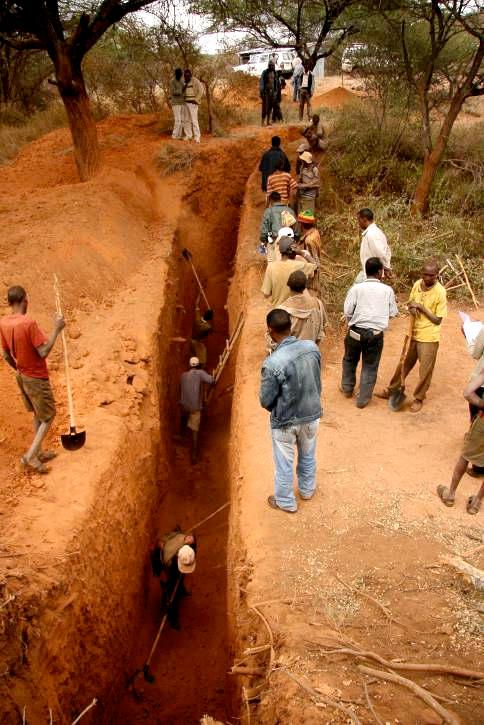
First a trench needs to be dug. Its position is marked out using pegs. Then it is excavated and the soil placed downstream. It can also be dug out into bedrock. It should then be checked for weathering zones and cracks. Round bars are placed vertically along the trench to reinforce it. Then a foundation is laid consisting of 2 layers of cement with barbed wire in between. Once this has set, the trench is filled with masonry or mortar and hardcore. The wing walls and final dam wall can then be constructed. Finally any exposed parts of the construction are plastered. 首先,需要挖取一个沟渠,用桩子标记地点。随后,挖取沟渠,将土壤置于下游。也可以挖到基岩处。然后,需要检查风化带和裂缝。圆形杆子沿沟渠垂直放置,用以加固。之后,铺设地基。地基由两层含带刺铁丝网的水泥构成。一旦地基铺设完成,沟渠由砖石或灰浆和岩石碎块填满。随后,可建造翼墙和最终的坝墙。最后,粉刷建筑物上任何裸露的部分。
建造沙坝(以及翼墙)
对于水泥的总体建议:A common cause of cracks in structures and linings (e.g. in tanks, dams, waterways, wells) is errors in mixing and applying the cement. First of all, it is important that only pure ingredients are used: clean water, clean sand, clean rocks. The materials have to be mixed very thoroughly. Secondly, the amount of water during mixing needs to minimal: the concrete or cement needs to be just workable, on the dry side even, and not fluid. Thirdly, it is essential that during curing the cement or concrete is kept moist at all times, for at least a week. Structures should be covered with plastic, large leaves or other materials during the curing period, and kept wet regularly. 建筑物产生裂缝(如,水槽、坝体、排水沟、井)的普遍原因是水泥混合和施用不当造成的。首先,只用纯净原料(干净的水、沙、石头),这一点至关重要。原料必须充分混合。第二,混合时需要的水量极小:混凝土或水泥能用即可,不稀且较干。第三,在固化过程中,水泥或混凝土至少一周都必须保持水分。在固化过程中,建筑物应该由塑料、大树叶或其它材料加以覆盖,保持水分。
具体建议
- Timing is important: dams should be built during the dry season, but don’t build dams too close to the rains in order to avoid the trench filling up with water or the dam being washed away.时间安排很重要:建坝需在旱季进行,且勿太临近雨季,以避免沟渠被水填满或坝体被冲走。
- The method depends on the type of dam and the type of ground. The construction of sand dams in cascades improves total storage and efficiency and minimizes seepage losses. Dams made of concrete, stone-masonry (cheapest and easiest) and brickwork require skilled labour for construction, but are stronger and have a longer lifespan. 建坝方式由水坝类型和地质类型来决定。在梯级地形上建造沙坝能提升总储水量和效率,并将渗流损失降至最低。建坝方式由水坝类型和地质类型来决定。在梯级地形上建造沙坝能提升总储水量和效率,并将渗漏损失降至最低。混凝土、砌石(最便宜、最简单)和砌砖建成的水坝虽然需要技术娴熟的工人来建造,但会更坚固,使用寿命也更长。
- Usually sand dams are built onto a rock layer, but where there is no rock and only clay, it can still work but as long as the foundation is keyed into the clay layer and where the wall does not protrude more than 0.5m above original sand level, otherwise there is a risk the structure overturns during a flood event.通常,沙坝要建在岩层上,但在没有岩石而只有黏土的情况下,只要地基能嵌进黏土层,且坝墙不超出原有沙层0.5米,沙坝仍能运行;否则在洪水期间,坝体有倾覆的危险。
- Key into banks or construct wing walls to avoid erosion around edges of the sand dam. Where wing walls are built, a good technique is to start with the wing walls and work inwards to the centre, since community enthusiasm lags by the time wing walls are constructed (if not built first), yet they are essential to proper functioning. Length of the wing wall varies according to bank characteristic: loose riverbanks, 7 metres; hard soils, 5 metres; hard & impermeable soils or rocks, wing wall is not needed. Planting napier grass along upstream riverbanks controls erosion and fixes the course of the river in a flood.坝体需嵌入河堤,或建造翼墙来防止沙坝边缘侵蚀。建造翼墙的情况下,较好的方法是先从翼墙开始建造,然后向中心动工。如果不先建造翼墙,社群的建造热情会在翼墙竣工前就下降,而翼墙对沙坝的正常运作来说至关重要。翼墙的长度随河堤的特性而定:松散的河堤,7米;硬质的土壤,5米;不透水且硬质的土壤或岩石则不需要翼墙。在上游河堤种植象草可以控制侵蚀,并在洪水中修正河道。
- The height of wall built before each flood event should not exceed accumulation rate of coarse to medium sand during that flood event, otherwise ponding & silt deposition will occur, which can lower specific yield and higher capillarity, then lead to limited extraction rates in wells upstream and more water lost to evaporation. Dams at 1.3m depth showed that where finer material content (0.063 mm or less) is increased, specific yield is known to decrease remarkably. Accumulation rate and therefore height varies according to location and should be adjusted at each site after the first flood event demonstrates the rate of accumulation. Height per stage will probably be between 0.3 metre and 1 metre per stage according to experience from past projects. Some silt deposition will always occur as velocities decrease toward the end of the flood event; the idea is to limit its quantity in final sand volume.在每次洪水来临前建造的坝墙高度不能超过当季洪水里粗砂至中粒砂堆积速率,否则会出现积水成池和泥沙沉积,这将降低单位出水量且增加毛细管作用,而导致位于上游的井取水率有限且更多水分蒸发流失。观察1.3米深的水坝显示,当更精细的物质成分(小于等于0.063毫米)增高,单位出水量会显著降低。堆积速率及相应的坝墙高度根据具体位置而定,且需要在第一次洪水来临后得出堆积速率,从而对每一位置的坝墙高度进行调整。根据以往工程的经验来看,每一阶段的坝墙高度差不多在0.3米至1米之间。随着洪水消退,由于速率下降,总是会出现一些泥沙沉积;这一点用来限制最终沙量中的泥沙沉积。
- Avoid downstream erosion problems by making a protective slab (stilling basin) at the base of large stones set in concrete. Dimensions to be designed, but is not necessary where there is exposed rock bar downstream.通过在混凝土中的大石块底部建造防护板(消力池),防止下游的侵蚀问题。防护板尺寸需要设计,但不一定是下游有裸露石块的区域的大小。
- In upstream parts of a catchment it is recommended that sand dams are always built in stages, since the availability of coarse material is generally limited and base flow is small or absent (base flow = sub-surface flow which aids surface flow so that silt/clay can still be flushed away once rainfall stops, rather than sinking directly into the sand bed). It has also been suggested that to build in stages over several years is also more beneficial for functioning of dam committees. Build them within a spillway, which was part of the first stage & wing wall construction.在流域的上游,由于粗粒物质通常有限,且建议沙坝始终分阶段建造,基流很小或没有基流(基流=有助于地表径流的地下水流,只要降雨停止,淤泥/黏土仍可被冲走,而不会直接沉入沙床)。也建议在几年中分阶段建设,这也更有益于沙坝委员会的运作。将它们建在溢洪道中,这是第一阶段和翼墙建造的一部分。
取水
After the dam is built, an outlet for water extraction must be constructed for drinking, agriculture, etc. Hand dug scoop holes are the simplest possibility, however the water can easily be contaminated. Covered shallow wells, either with or without Handpumps or a Rope pump protect the water much better. It is also possible to construct an outlet pipe with a tap. In certain designs for sand dams, a pipe is shown that takes water by gravity through the dam wall. These are said to not work well due to either a blocked intake, a broken tap on outlet side and the possibility of weakening the dam wall. Where water is abstracted directly, risk of contamination increases. In such a case, household water treatment should be advocated (e.g. Sodis).
沙坝竣工后,必须建一个取水出口,用于饮水、农业等用途。用手挖勺洞是最简单的方法,但水容易受污染。有盖浅井,无论带不带有手压泵或拉绳泵,都可以更好地保护水资源。也可以建造带有龙头出水管来取水。关于沙坝的设计中,水管能运用重力输送水资源经过坝墙。据称,由于入水口堵塞或出水口龙头损坏,以及坝墙可能松动,取水管运作不良。而直接抽水的地方,污染的风险会增加。在这种情况下,应该提倡家庭用水的处理(如,太阳能消毒)。
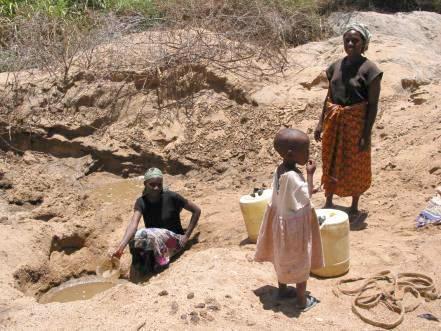

维护
If done timely, the maintenance required is not costly. Small malfunctions in the dam however can lead to destruction of the entire dam. Therefore, the dam should be regularly checked for cracks and damage. Particularly after floods, and extreme temperature changes cracks are likely. These need to be repaired as soon as possible by a trained mason. During the dry season, raised-sand dams should be raised by a maximum of 50 cm if the reservoir has filled up.如果及时维护,所需的维护成本并不会很高。然而即使是沙坝出现小故障,也能导致整座沙坝遭到毁坏。因此需要定期检查沙坝有无裂缝和损坏。尤其是在洪水过后,以及极端气温变化之下,沙坝很有产生裂缝。这些裂缝需要尽可能及时地由熟练的石匠进行修复。在旱季,如果水库是满的,则已提高的沙坝需要再提升到最高50厘米的范围内。
Further, the outlet and upstream riverbed should be cleaned regularly to make sure the dam does not get blocked. Silt, rocks, dead animals, etc. should be removed regularly. This can also help prevent contamination of the water. The quality of the water in the well should be checked, once in a while, by an expert. 而且,出水口和上游河床需要定期清理,确保沙坝不会堵塞。淤泥、石块和动物死尸等需要定期清除。这也能帮助防止水污染。井中的水质需要间或由专家进行检查。
Maintenance can normally be carried out by the users of the system or by a caretaker or watchman. Larger repairs may require skilled labour, which can usually be provided by local craftsmen. In some cases, unskilled labour may be required on a large scale (e.g. for repairing a broken raised-sand dam, or a leaking subsurface dam). The labour may be provided by the users (with or without pay), or by other people who are hired for the purpose.一般可以由沙坝系统使用者、管理员或看守人来实施维护工作。较大的修补工作可能需要技术娴熟的工人来进行,通常可以找当地的工匠。有些情况下,大规模的修补也会需要非技术工人(如,修补已提高过的故障沙坝,或渗漏的地下水坝)。可以由沙坝使用者提供劳动力(有或没有薪酬),或雇佣其他人来修补。 Users may need to establish a local committee to manage issues, such as controlling or supervising water use, preventing water contamination, carrying out O&M activities, financing O&M, and monitoring how much stored water is still available (a piezometer or auger hole may be installed to allow a caretaker or watchman to estimate how much water is left and decide if rationing has to be introduced). Proper management may also help to prevent social conflict. For O&M tasks at the dam site, a person who lives or farms near this site could be appointed. This person could also be responsible for water allocation and be involved in monitoring activities, if users obtain the water near to, or at, the site. His or her authority should be clear and accepted by all users.使用人可能需要成立一个当地委员会来管理沙坝问题,如,控制或监督用水,防止水污染,运行与维护的实施与财政管理,以及监测还有多少储水可供使用(可能需要安装压强计或用螺旋钻钻孔,以便管理员或看守人可以判断剩余水量,并决定是否有必要采用定量配给制)。适当的管理也可帮助防止社会矛盾。沙坝现场的运行与维护任务可以指派给住在附近或在附近务农的人。如果使用沙坝的人在沙坝或附近取水,这个人也可以负责水的分配,并加入监督工作。这个人需要权利明晰,并由所有使用人同意。
In order to insure success at all stages of construction, operations and maintenance, the local community needs to be trained as well to manage and maintain the dam. Promote catchment-level planning & management so that varying groups have a vested interest in the same source. They can start to address improvements in soil/water conservation, food production & health. Previous dam committees have shown that they tend to stop functioning effectively after the construction phase. By taking longer to build the dam, e.g. 3 stages over 3 years, it may give enough time for a catchment-based dam association to form & start functioning.为了确保建造、运行和维护的每一阶段都能成功进行,当地社区也需要接受培训,以便于管理、维护沙坝。促进流域层面的规划和管理,从而不同的群体可以享有同一水源的既得利益。他们可以开始改善土壤/水源的保护、提升粮食生产并促进健康。先前的水坝委员会倾向于在竣工后停止工作。用更多时间建造沙坝,如,3个阶段跨越3年之久,这样能有足够的时间让处于流域区的水坝协会去建立组织,开始运作。
Brikke和Bredero在著作Linking technology choice with operation and maintenance in the context of community water supply and sanitation: A reference document for planners and project staff 中,推荐如下图表中的运行与维护工作:
预计使用寿命
The lifespan depends on the materials used and expertise with which it is constructed and maintained. The dams in Kitui Kenya were built at a cost of US$7,500 and have a minimum lifespan of 50 years.沙坝的使用寿命由两方面来决定:第一,使用的建材;第二,建坝和维护时使用的专业知识。肯尼亚基图伊的水坝耗资7500美元,最短使用寿命为50年。
成本
The construction of dams is largely carried out by the local community. Costs mainly relate to local availability of cement, masonry and professional supervision.建坝主要是由当地社区实施的。成本主要取决于当地能否提供水泥、石工技术和专业监管。
引进成本:
- 建材:US$ 5,500
- 其它成本:US$ 500
- 劳动力: - 技术工:US$ 2,500 - 非技术工: 900人工日 -
维护成本:
- 运行与维护:每年5天
The cost of a sand dam in Kenya was very low, yielding 2,844 m3 of water was US$3,260 = US$1.15 per m3 storage.在肯尼亚,沙坝的花销非常低廉,产出2844立方米的水需要3260美元,即每立方米储水需1.15美元。
The cost to benefit ratio for the sand dam's first year of operation is 1:12.沙坝第一年运作的成本效益比为1:12。
实地经验
In Kenya, it has been used with good outcome in the Kitui, Machakos and Samburu districts. Other countries with similar dry environments such as the U.S.A, Thailand, Ethiopia and Namibia also have used it in numerous and diverse forms.在肯尼亚,基图伊、马查科斯和桑布鲁地区使用了沙坝,并取得了良好的成效。其它有相似的干燥环境的国家,例如,美国、泰国、埃塞俄比亚和纳米比亚,也以多种多样的形式使用沙坝。
肯尼亚的基图伊地区: SASOL Foundation has since 1995 built over 500 dams. They are built using locally available materials and are partially (40%) financed by the local community. The community is also involved in the construction and maintenance. Sand management groups were formed to aid in the construction of dams and to maintain them after. SASOL基金会自1995年起已建造了超过500座水坝。这些水坝是运用当地可供的材料建造的,并且,部分(40%)是由当地社区出资的。社区也参与沙坝的建造和维护。为了在建坝期间提供帮助,并在竣工后进行维护,若干个沙子管理组由此建立。
The dams not only provide a steady source of drinking water, but also have further social and economic benefits. They provide irrigation for cash crops and other commercial rural activities, piped water for industrial activities in nearby villages. Further due to the large number of dams, the water table rises over a large area and therefore stimulates ecological regeneration. 水坝不仅能提供稳定的饮用水源,也能带来更深远的社会和经济利益。它们能为经济作物及其它农村商业活动提供灌溉,也为邻近村庄的工业活动提供自来水。而且,由于水坝数量众多,大区域的地下水位升高,因此促进了生态复兴。
埃塞俄比亚的波拉纳地区: Communities in this area depend on agriculture and livestock farming, which is very limited due to the unstable water supply. In 2007 several NGOs implemented 7 sand dams and 10 surface runoff tanks. This combination should provide a reliable source of water for 10 communities in the area. The project will in the future expand to other parts of the country also.这里的社区依靠农业和畜牧业为生,但供水不稳定,因而非常受限。2007年,几个非政府组织建成了7座沙坝和10个地标径流水池。这样的组合能为这里的10个社区提供可靠的水源。这一项目也会在将来扩展到埃塞俄比亚的其它地区。
Akvo RSR项目
The following project utilize sand dams.利用了沙坝的项目有:
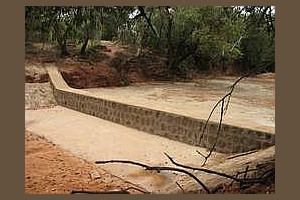 Dawa Eresa地下水与沙坝项目 |
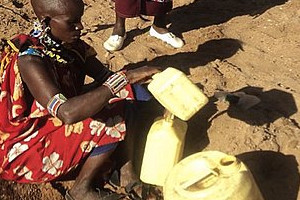 对雨水收集的可行性研究 |
 Wateroogst: Konso Woreda/Eshimale |
指南,视频与链接
- 指南:A practical guide to sand dam implementation。雨水收集实施组织(RAIN)。
- 指南:Manual on sand dams in Ethiopia:沙坝选址、设计与建造的实用方法。结合沙坝与其它雨水收集建筑物的工具。埃塞俄比亚雨水收集协会(ERHA)与 RAIN基金会。
- 指南:Before the Deluge: Coping with Floods in a Changing Climate. 如何应对气候变化造成的洪水。国际河流组织。
- 指南:Sand Dams: Feasible Rainwater Harvesting Technology for Arid and Semi-arid Lands. 实际行动。
- 文档:FAQs on Sand Dams. 由卓越/非洲沙坝基金会(Excellent/ASDF)提供,由达班信托贡献(Dabane Trust)。
视频
与2009年埃塞俄比亚实地考察 |
项目 - 肯尼亚,2010 |
链接
- Excellent: Pioneers of San Dams.
- ACACIA Water. The strength of Acacia Water is the specialization in the field of groundwater, while at the same time being able to place issues in a broader perspective and to link up with other fields of action. As a result we often work in a multidisciplinary environment with a broad variety of expertise.
- IAH. IAH-MAR is a forum for information on the work within the international groundwater community on the management and enhancement of aquifer recharge, a vital tool in the sustainable management of the world's underground water resources.
Acknowledgements
- CARE Nederland, Desk Study: Resilient WASH systems in drought-prone areas. October 2010.
- Brikke, François, and Bredero, Maarten. Linking technology choice with operation and maintenance in the context of community water supply and sanitation: A reference document for planners and project staff or (alternative link). World Health Organization and IRC Water and Sanitation Centre. Geneva, Switzerland 2003.
- Maddrell S and Neal I, Sand dams: a Practical Guide, Excellent Development, London. 2012.
- Jacob H. Stern, Ph.D and Alvera Stern, Ed.D, et al. Water Harvesting Through Sand Dams. ECHO Technical Note. 2011


